Good books have always served as venues for lessons on life. Wilbur and Fern taught us about friendship, persistence, and trust in Charlotte’s Web. Anne of Green Gables taught us the value of a great imagination and the strength of friendship. Books can mirror our own lives or create windows into worlds we've never dreamed of before. This month’s theme for book reviews from the IRA Children’s Literature and Reading Special Interest Group is friendship. The books selected range in age level and type of friendship, but the central theme of each is the power of friendship and the different forms friends often take.
AGES 2-7
Dyckman, A. (2012). Boy + Bot. New York: Knopf Books for Young Readers.
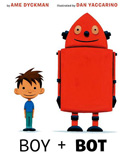 A friendship boots up between a robot and a boy in this sweet story about finding friendship in unlikely places. The two play and have a great time until the robot suddenly stops responding (his switch has been turned to off). The boy takes him home and tries all sorts of things that would make a boy feel better, from feeding him applesauce to reading him a story. It’s not until his parents accidentally bump a door into the robot’s switch that the robot comes back on. Likewise, when the little boy goes to sleep the robot believes he has malfunctioned. Finally, the robot’s inventor helps to set things straight in this gentle story of friendship.
A friendship boots up between a robot and a boy in this sweet story about finding friendship in unlikely places. The two play and have a great time until the robot suddenly stops responding (his switch has been turned to off). The boy takes him home and tries all sorts of things that would make a boy feel better, from feeding him applesauce to reading him a story. It’s not until his parents accidentally bump a door into the robot’s switch that the robot comes back on. Likewise, when the little boy goes to sleep the robot believes he has malfunctioned. Finally, the robot’s inventor helps to set things straight in this gentle story of friendship.
- Nancy Hulan, Western Kentucky University
Stead, P.C. (2010). A Sick Day for Amos McGee. New York: Roaring Brook Press.
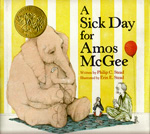 A winner of the Caldecott Medal, this book beautifully tells the tale of a zookeeper who befriends the zoo animals where he works. Each day he does the same thing, playing chess with the elephant, running races with a tortoise that never loses, reading stories to the owl…until one day he wakes up with the sniffles. When Amos does not show up to the zoo, his friends decide to pay him a visit. This story and the wonderful illustrations portray the many things we do for dear friends and the ways friends help us when we are under the weather.
A winner of the Caldecott Medal, this book beautifully tells the tale of a zookeeper who befriends the zoo animals where he works. Each day he does the same thing, playing chess with the elephant, running races with a tortoise that never loses, reading stories to the owl…until one day he wakes up with the sniffles. When Amos does not show up to the zoo, his friends decide to pay him a visit. This story and the wonderful illustrations portray the many things we do for dear friends and the ways friends help us when we are under the weather.
- Nancy Hulan, Western Kentucky University
Stephens, H. (2013). How to Hide a Lion. New York: Henry Holt Publishers.
 Sometimes our parents just don’t see the good in our friends. Such is the case when a lion comes to town to purchase a new hat and is chased by grownups in true Frankenstein and villagers style. Iris finds him hiding in her playhouse and tries to hide and protect him from the grownups. Ultimately, the lion proves his worth and goodness and still hopes to purchase that hat.
Sometimes our parents just don’t see the good in our friends. Such is the case when a lion comes to town to purchase a new hat and is chased by grownups in true Frankenstein and villagers style. Iris finds him hiding in her playhouse and tries to hide and protect him from the grownups. Ultimately, the lion proves his worth and goodness and still hopes to purchase that hat.
- Nancy Hulan, Western Kentucky University
AGES 8-12
Applegate, K. (2012). The One and Only Ivan. New York: Harper Collins.
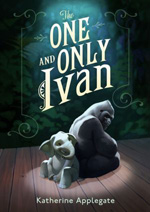 The One and Only Ivan is written in first person from the point of view of Ivan, an artistic silverback gorilla living in a shopping mall. When we meet Ivan, he seems sadly complacent with his lot in life and barely ever thinks of his past in the jungle. His companions at the Exit 8 Big Top Mall include Bob, a stray dog, Stella, a motherly elephant, and Ruby, a baby elephant who inspires Ivan to make some changes. Ivan wants to save Ruby from a lifetime of captivity like his own and uses his artistic expression to help keep her from living a life like his. Winner of the 2013 Newbery Medal, this story demonstrates the power that each individual has to make extraordinary change in the world.
The One and Only Ivan is written in first person from the point of view of Ivan, an artistic silverback gorilla living in a shopping mall. When we meet Ivan, he seems sadly complacent with his lot in life and barely ever thinks of his past in the jungle. His companions at the Exit 8 Big Top Mall include Bob, a stray dog, Stella, a motherly elephant, and Ruby, a baby elephant who inspires Ivan to make some changes. Ivan wants to save Ruby from a lifetime of captivity like his own and uses his artistic expression to help keep her from living a life like his. Winner of the 2013 Newbery Medal, this story demonstrates the power that each individual has to make extraordinary change in the world.
- Nancy Hulan, Western Kentucky University
House, S. & Vasmani, N. (2012). Same Sun Here. Somerville, MA: Candlewick Press.
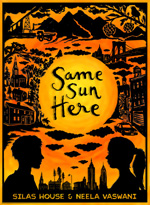 Written in letter-form, this book spans a year in the lives of River and Meena. River, a coal miner’s son in the mountains of eastern Kentucky and Meena, an immigrant from India who lives in New York City become pen pals through a school project. They realize that they have found kindred spirits in one another and their unlikely friendship empowers the two pre-teens to find the strength to stand up for themselves and their ideals. They confront one another truthfully about issues of race, religion, culture, gender, creativity, and uncertain futures. With one another’s support, River stands up to coal companies and their use of Mountaintop Removal and Meena struggles to keep her family intact through uncertainty of immigration and shaky citizenship status. This book would be a great tool to foster discussion on issues of immigration, environmentalism (specifically MTR), cultural differences, and acceptance.
Written in letter-form, this book spans a year in the lives of River and Meena. River, a coal miner’s son in the mountains of eastern Kentucky and Meena, an immigrant from India who lives in New York City become pen pals through a school project. They realize that they have found kindred spirits in one another and their unlikely friendship empowers the two pre-teens to find the strength to stand up for themselves and their ideals. They confront one another truthfully about issues of race, religion, culture, gender, creativity, and uncertain futures. With one another’s support, River stands up to coal companies and their use of Mountaintop Removal and Meena struggles to keep her family intact through uncertainty of immigration and shaky citizenship status. This book would be a great tool to foster discussion on issues of immigration, environmentalism (specifically MTR), cultural differences, and acceptance.
- Nancy Hulan, Western Kentucky University
AGES 10-14
Gantos, J. (2011). Dead End in Norvelt. New York: Farrar Straus Giroux.
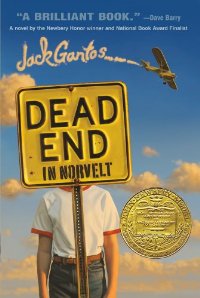 Jack is grounded for life after accidentally firing his father’s Japanese rifle and mowing down his mom’s corn crop. On top of that, his nose spews blood at any little excitement. His summer looks dreary until a call from Miss Volker, an elderly neighbor whose hands are too arthritic to type her obituaries of the last remaining original Norvelters. She enlists Jack to type and drive and in doing so provides him with some salvation. Jack’s imagination and love of history help him through summertime boredom and the wild adventures that accompany each obituary he and Miss Volker write. Through wax hands, unusual bodily tactics to save a deer, arson in a utopian town, mysterious deaths of old ladies, and raids by Hells Angels, Jack and Miss Volker forge an unlikely and powerful friendship. Dead End in Norvelt won the 2012 Newbery Award. Gantos has recently published the sequel that continues the adventures of Jack and Miss Volker in From Nowhere to Norvelt (2013).
Jack is grounded for life after accidentally firing his father’s Japanese rifle and mowing down his mom’s corn crop. On top of that, his nose spews blood at any little excitement. His summer looks dreary until a call from Miss Volker, an elderly neighbor whose hands are too arthritic to type her obituaries of the last remaining original Norvelters. She enlists Jack to type and drive and in doing so provides him with some salvation. Jack’s imagination and love of history help him through summertime boredom and the wild adventures that accompany each obituary he and Miss Volker write. Through wax hands, unusual bodily tactics to save a deer, arson in a utopian town, mysterious deaths of old ladies, and raids by Hells Angels, Jack and Miss Volker forge an unlikely and powerful friendship. Dead End in Norvelt won the 2012 Newbery Award. Gantos has recently published the sequel that continues the adventures of Jack and Miss Volker in From Nowhere to Norvelt (2013).
- Nancy Hulan, Western Kentucky University
These reviews are submitted by members of the International Reading Association's Children's Literature and Reading Special Interest Group (CL/R SIG) and are published weekly on Reading Today Online. The International Reading Association partners with the National Council of Teachers of English and Verizon Thinkfinity to produce ReadWriteThink.org, a website devoted to providing literacy instruction and interactive resources for grades K–12.